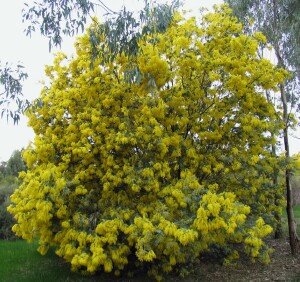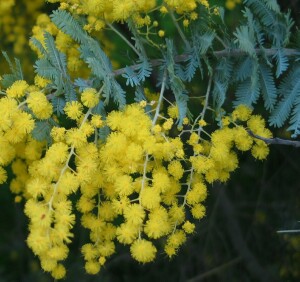Curse of the Cootamundra wattle
Posted on 22 August, 2019 by Ivan
A weedy wattle? That’s bloomin crazy!
Cootamundra wattle (Acacia baileyana) is out in full bloom at the moment, providing a bright and timely reminder that winter is nearing its end and Spring is on its way. Although the Cootamundra wattle is native to New South Wales, it has become an invasive plant in many regions across the country, including the Mount Alexander Shire. You will find this species with bright yellow blossom in our local bushlands right now, and believe it or not, it is still used occasionally in new planting in our region.
The Cootamundra wattle is a widely cultivated species that invades drier areas where annual rainfall exceeds 400 mm. It grows on a range of soil types, although not permanently sodden or waterlogged soils. Cootamundra wattle readily invades our native heathland and heathy woodland, lowland grassland and grassy woodland, dry sclerophyll forest and woodland, and riparian vegetation.
It is a shrub or tree that grows to 10 m high with a spreading crown and smooth grey or brown bark on the main stem and most branches. The branchlets and younger branches have prominent vertical ridges and are covered with a whitish, waxy bloom. They sometimes also bear numerous short soft white hairs. The leaves are bipinnate (finely divided into small leaflets giving the leaves a ‘feathery’ or ‘fern-like’ appearance) and silvery grey-green or blue-green with a whitish bloom. Compared to many other bipinnate-leaved wattles, the leaves of Cootamundra Wattle are relatively short and usually have only 2-4 (sometimes up to 6) pairs of leaflets. The ball-shaped, golden yellow flower heads are arranged in ‘sprays’ (racemes) up to about 10 cm long that clearly exceed the leaves. These are followed by more-or-less straight-sided, purplish-brown to black seed-pods, 30-100 mm long and 8-15 mm wide, that sometimes have a white waxy bloom. The hard, black seeds are about 5 mm long and 3 mm wide.
Across our region, Cootamundra Wattle was extensively planted in gardens and shelter-belts in the prior decades, before we realised it was a problem. Unfortunately it is still widely available in nurseries, garden centres, fetes and markets. The hard, long-lived seeds are spread by birds and ants, on machinery and in garden waste.
Connecting Country strongly recommend that people do not plant this species, as it can quickly spread and invade healthy ecosystems and nature reserves. Instead consider one of our local indigenous Acacia species, which can be found by clicking here.
The North Central Catchment Management Authority has an excellent brochure on how to identify this species to similar ‘look-a-like’ species, click here bipinnate wattle identification.

Cootamundra Wattle in full flower (photo: Agriculture Victoria)

Cootamundra Wattle Flowers (photo: Agriculture Victoria)






Leave a Reply